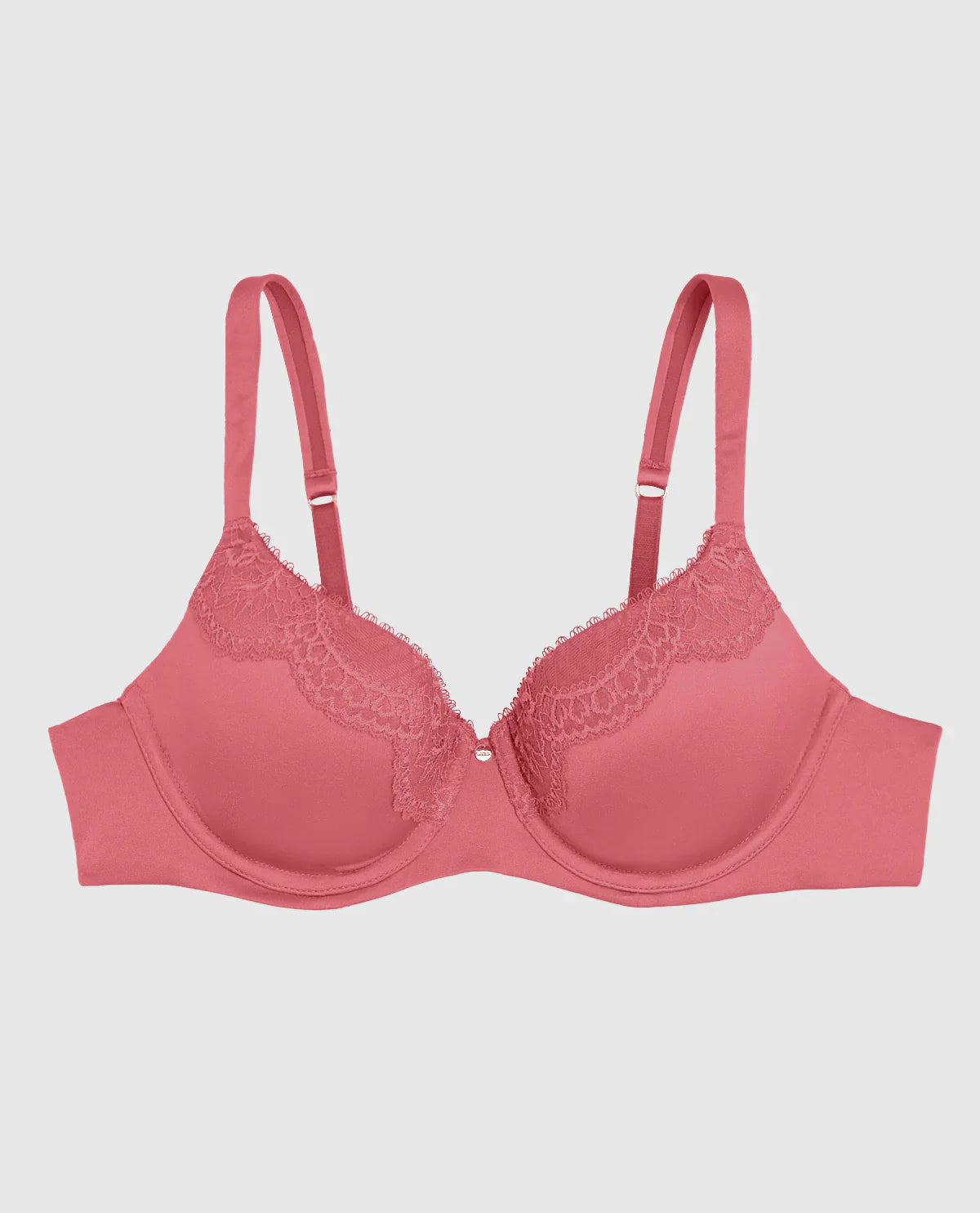Guide to the Best Sister Sizing Bra Chart for Perfect Fit

Looking for a better bra fit? A sister sizing bra chart can guide you to alternative sizes that maintain the same cup volume, ensuring comfort and support. In this article, we will explain what sister sizes are, why they matter, and how to use the sister sizing bra chart to find your perfect bra.
Sister sizes are different band sizes with the same cup volume, allowing for greater flexibility in finding a comfortable and well-fitting bra. Understanding and calculating sister sizes enhances the bra shopping experience by offering alternatives when traditional sizes are uncomfortable or unavailable. Using a sister size chart simplifies identifying alternative sizes, helping to solve common fit issues such as gaping cups and tight bands.
Understanding Sister Sizes

Sister sizes are a revelation for anyone struggling to find a comfortable and supportive bra. These sizes are different band sizes with the same cup volume and the same size, effectively broadening your options without sacrificing fit. For instance, a 34B and a 32C are sister sizes because they maintain equivalent cup volumes while varying the band length. Understanding sister bra sizes and your current bra size sister can help you find the perfect fit.
The principle behind sister sizing is rooted in the relationship between band size and cup volume. As the band size increases, the cup size decreases to keep the volume consistent, and vice versa. This means if you go down a band size, you’ll need to go up a cup size to maintain the same volume of breast tissue.
Consider the example of a 34C and a 36B. Though the band sizes differ, the cup volume remains the same, providing a consistent fit across these sizes. This flexibility extends to half-cup sizes as well, which can be particularly useful for achieving that perfect fit.
Understanding sister sizes can transform your sister bra shopping experience. Knowing your bra sister sizes opens up a wider range of bras that can better accommodate your unique shape and preferences.
Why Sister Sizing is Important
Sister sizing is more than just a tool for finding the right fit; it’s a game-changer for comfort and confidence. Many women discover that their usual size doesn’t always provide enough support or comfort. They provide the flexibility to explore different sizes while retaining the optimal cup volume.
For instance, a woman who couldn’t find a comfortable 36B might discover that a 34C fits perfectly, providing better support and a more flattering silhouette. This flexibility becomes particularly useful when your usual size is either unavailable or uncomfortable. It enables you to adjust and find the best fit, thereby enhancing comfort and appearance.
The key advantage of sister sizing is the increased range of options it provides:
-
It helps when dealing with a tight band or gaping cups.
-
Sister sizes maintain the same cup volume while adjusting the band size.
-
This translates to more choices and a greater likelihood of finding a perfect-fitting bra.
How to Calculate Your Sister Size
Calculating your sister size is simple and can lead to a world of better-fitting bras. Start by accurately measuring your current bra size.
Once you have your measurements, you can determine whether you need to go up or down in band size and adjust the cup size accordingly.
Measure Your Current Bra Size
Measuring accurately is crucial for finding the right bra fit. Follow these steps to find a bra:
-
Wear a non-padded bra to ensure the most accurate results.
-
Wrap a measuring tape around the fullest part of your chest.
-
Ensure the tape is snug but not too tight.
This will help determine your cup size.
Then, measure your band size by wrapping the tape snugly around your rib cage, just under your bust. This step is crucial for a comfortable fit, as the band provides most of the bra’s support. Compare these measurements with a bra size chart to find your current bra size.
Armed with your current bra size, you can now explore your sister sizes. The goal is to maintain the same cup volume while adjusting the band size for the best fit.
Determine If You Need to Go Up or Down in Band Size
Deciding whether to go up or down in band size can be tricky but is essential for a perfect fit. Begin by assessing your current band size fit issues. If your band feels overly tight or restrictive, a larger band size might be needed. This adjustment may provide you with a more comfortable fit. Conversely, if the band rides up your back or feels too loose, a smaller band size feels might be necessary.
If you go up a band size, go down a cup size to maintain the same volume. For instance, if a 34B feels tight, try a 36A. If the cups feel too big while the band fits well, it can be a bit trickier to find a smaller cup size.
Comfort is key; ensure your great fitting bra hooks comfortably on the middle loosest hook for a perfect fit. Sister sizing adjustments can help achieve a perfect bra fit.
Sister Sizing Bra Chart
A sister size chart is invaluable for navigating bra sizes. It visually shows the relationship between different band sizes and their corresponding cup volumes. For instance, a 34C is the same as a 36B, and a 40E(DD) is equivalent to a 42D, illustrating bra size equivalents.
To use the chart, first locate your current bra size. Then, examine the sizes in the same row. This will help you find your sister sizes. This method maintains the same cup volume while exploring different band sizes. For example, a 36D’s sister sizes would be 34DD and 38C. Finding the perfect fit is also important when choosing comfortable and stylish pajamas for a restful night's sleep.
Using a bra sister size chart can simplify bra shopping. It allows you to see all possible options at a glance, ensuring the best fit for your unique shape and preferences.
How to Use a Sister Size Chart
Using a sister size chart can simplify the often overwhelming process of bra shopping. Knowing your sister size offers alternative options, especially when your regular size is unavailable or doesn’t feel right. To find your sister size, first identify your current bra size on the chart.
After finding your size, look at the sizes that are one band size up or down. These are your sister sizes. If a chart isn’t available, manually calculate sister sizes by adjusting the band and cup sizes according to established ratios.
The sister size chart shows sizes with equivalent cup volumes in the same row, making it easy to reference and find your perfect fit. This visual guide is essential for anyone looking to explore alternative sizes and achieve a better fit using sister size charts.
Common Fit Issues and How Sister Sizes Help
Common fit issues can make bra shopping a nightmare. These include:
-
Gaping cups
-
Spillage
-
Underwire discomfort
-
Bands that are too tight or too loose These problems often result from wearing the wrong bra size and can cause significant discomfort.
Sister sizes provide an excellent solution to these fit problems. Sister sizes offer alternative size options that maintain the same cup volume, enabling a more comfortable and supportive fit. For example, if a band’s tightness is the problem, choosing a larger band size while adjusting the cup size down can make a huge difference.
Understanding and using sister sizes can help you achieve the perfect fit, ensuring your bra provides both comfort and support.
Tips for Trying On Bras Using Sister Sizes
Trying on bras can be daunting, but sister sizes can make it more manageable. Ensure the band is snug yet comfortable, maintaining a horizontal position across your back. This helps ensure you’re getting the right support.
Next, check the fit of the underwire. It should:
-
Lay flat against your rib cage
-
Have cups that surround your breasts completely, with no gaps or overflow.
It’s beneficial to try different sizes and bra styles, as not all bras fit the same way. With sister sizes, you can explore a range of options to find the perfect bra for your unique shape, including a new bra style.
Benefits and Limitations of Sister Sizes
Sister sizes offer significant benefits, including:
-
Providing flexibility to find alternatives if a particular size is unavailable.
-
Being particularly useful for adapting to body size changes over time.
-
Ensuring a comfortable and supportive fit.
Key points about sister sizes:
-
Sister sizes work best when adjustments are limited to one size change in either direction. Bra sister sizes work effectively within this range.
-
Going beyond one size change can significantly alter the bra’s fit and support, making it less effective.
-
Sizes can vary significantly across different brands, so sister sizing may differ between manufacturers.
Despite these limitations, sister sizes remain valuable for finding the right fit and enhancing overall comfort and support, providing more room, with sister sizes shown.
Real-Life Examples of Sister Sizing
Real-life examples illustrate the impact of sister sizing on comfort and support. One woman shifted from a 36B to a 36D after a fitting, realizing how much better the D cup fit her body and provided support. This experience highlights the transformative power of finding the right size.
Another woman, who lost weight after childbirth, discovered her new size was a 34D. This adjustment greatly enhanced her comfort and appearance. It shows how sister sizing can adapt to body changes, ensuring continued comfort and support.
A third example involves a woman who went from a 36D to a 32DDD after a fitting. This drastic change significantly improved her comfort, proving that proper fit can make a huge difference. These stories underscore the importance of sister sizing in achieving the perfect fit.
Summary
Sister sizing offers a revolutionary approach to finding the perfect bra fit. By understanding and utilizing sister sizes, you can explore a range of options that maintain the same cup volume while adjusting the band size. This flexibility can transform your bra shopping experience, leading to increased comfort and support.
Remember, the key to a great fitting bra is finding the right size. Use the tools and tips provided in this guide to discover your sister sizes and enjoy the confidence that comes with a perfect fit. Don’t settle for discomfort when a world of better-fitting bras is within reach.
Frequently Asked Questions
What are sister sizes in bras?
Sister sizes refer to different band sizes that maintain the same cup volume, providing an alternative fit option without altering breast volume. For example, if your size is a 34B, your sister sizes would be 32C and 36A.
How do I find my sister size?
To find your sister size, measure your current bra size and adjust the band size up or down while changing the cup size accordingly to maintain the same volume. This method will help you identify sizes that may fit better.
Why should I try sister sizes?
You should try sister sizes for greater flexibility and options, which can lead to a better fit and enhanced comfort, particularly if your standard size is unavailable or feels uncomfortable.
Can sister sizes vary between brands?
Yes, sister sizes can vary between brands, as sizing standards are not consistent across manufacturers. Therefore, it is advisable to try on different brands to determine the best fit.
What should I do if my band feels too tight or too loose?
If your band feels too tight, you should consider going up a band size and down a cup size. Conversely, if it feels too loose, opt for going down a band size and up a cup size.


